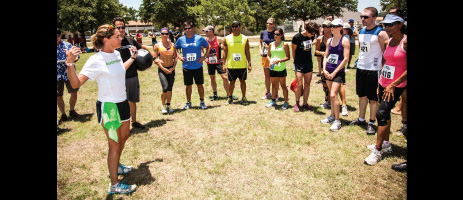We Woke the Giants!

Though the dust has settled, the adrenaline from the 2012 AFM FITTEST presented by Nexersys is still flowing. It was motivating to watch such a wide range of competitors come out; we saw fitness enthusiasts awaken their inner athletes and saw sport-specific athletes challenge their limits. The competition tested different areas of fitness as well as different energy systems, just as it was designed to do. As a result, both our great Austin endurance community and the power and strength community, which is growing in number, were challenged. Each athlete found challenges in areas outside of his or her sport-specific training and exposed individual weaknesses for improvement. Energized spectators and the thrill of pushing oneself in both familiar and unfamiliar activities fostered an exciting spirit of competition.The components of human performance involve a combination of power, speed, coordination, strength, speed endurance, and endurance. Each athlete may dominate certain areas of human performance based on his or her specific sport and training regimen. Take, for example, competitive cyclists; the energy systems they have adapted most specifically to their sport or activity become more dominant and these will differ from, say, a competitive weight lifter. As many sports medicine and strength and conditioning professionals can attest, an athlete’s resilience as well as her long-term fitness lies in those areas outside the sport-specific movements she is zeroing in on, mastering, and repeating. Don’t get me wrong—you must have high repetition in order to master, become more proficient, and adapt the energy systems required to compete at a higher level in your particular sport. But even some of the best athletes become prone to injuries, lose resilience, and sometimes are unable to reach higher levels of performance in their sports in the absence of balanced and multi-dimensional training practices. Having well-rounded athleticism can definitely prolong athletic careers and enable a lifetime of fitness.
For this reason, we included all aspects of performance in the AFM FITTEST, which mirrors the practice of many university athletic programs, military fitness tests, and current combine testing systems that originally became popular with American football. This type of testing is necessary in order to look at an athlete while performing specific sports skills as well as to assess the athlete’s ability to be injury-resistant and adapt to higher levels of sport-specific training. Therefore, we included a range of tests through the spectrum of human performance, making some intentional modifications so that the AFM FITTEST was accessible to all age groups and fitness levels.
Here’s how the individual tests covered the human performance spectrum:
Power was demonstrated in the Medicine Ball Toss (upper body) and Standing Broad Jump (lower body);
Speed was addressed in the 40-yard Dash;
Coordination and agility were encompassed in the Agility Cone Run and Softball Throw;
Strength was determined in Pull-Ups and the Hand Grip;
Strength Endurance was illustrated with Burpees;
Speed Endurance was demonstrated in the Interval Run;
Endurance was shown in the 1-Mile Run.
Several people hit me with the same big question: “Why can’t we do the mile first and get it out of the way?” Here’s the skinny: the order of events was chosen based on results seen by exercise researchers when testing the diverse human performance components in a single bout on the same day. What they’ve found is that it is important to arrange tests in an order that allows the energy systems to recover. A power movement (such as the Medicine Ball Toss) is performed very quickly and recovery, which is based on the body’s energy needs, can be quick as well. Although there will be some cumulative carryover from test to test, taking into consideration recovery needs allows the best advantage possible for athletes performing all the events on the same day during testing.
It was so inspiring to see the competitors embrace the areas where they were not as strong and take charge of the tests where they naturally excelled. These athletes showed tremendous effort, strong will, sportsmanship, and community by supporting each other every step of the way, which truly expresses what I consider to be the spirit of Austin’s fitness community. And a huge “hats off” goes to the fitness professionals who came together as sponsors, judges, coaches, and athletes. As an Austin-based fitness professional myself, the unified support across all fitness specialties and sport groups was incredible and inspiring to see.
We are already working on exciting ways to help competitors, trainers, and coaches with form, technique and more training programs that will translate to better overall performance next year for competing athletes. Without question, the AFM FITTEST is moving Austin’s fitness community closer to being a national leader in lifetime fitness!






